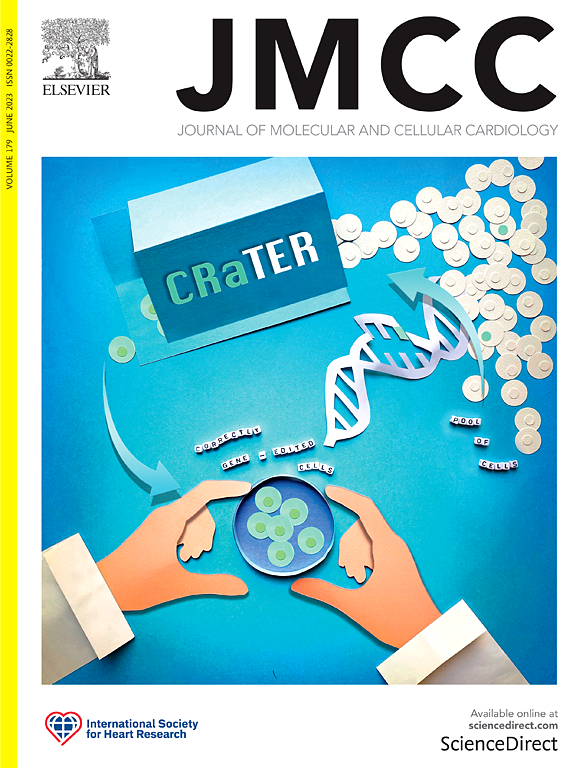KLF2-dependent transcriptional regulation safeguards the heart against pathological hypertrophy
IF 4.9
2区 医学
Q1 CARDIAC & CARDIOVASCULAR SYSTEMS
引用次数: 0
Abstract
Background
Our previous single-cell RNA sequencing study in the adult human heart revealed that cardiomyocytes from both the atrium and ventricle display high activities of Krüppel-like factor 2 (KLF2) regulons. However, the role of the transcription factor KLF2 in cardiomyocyte biology remains largely unexplored.
Methods and results
We employed transverse aortic constriction surgery in male C57BL/6 J mice to develop an in vivo model of cardiac hypertrophy, and generated different in vitro cardiac hypertrophy models in neonatal rat ventricular myocytes and human embryonic stem cell-derived cardiomyocytes. Our results demonstrated a significant reduction in KLF2 expression during the progression of cardiac hypertrophy. In vitro, Klf2 deficiency exacerbates cardiac hypertrophy and enhances hypertrophic reprogramming, while KLF2 overexpression attenuates cardiac hypertrophy and reverses hypertrophic transcriptome reprogramming. Mechanistically, combined RNA-seq and cleavage under targets & tagmentation (CUT&Tag) analysis revealed that KLF2 exerts its protective effects by directly regulating a set of genes associated with cardiac hypertrophy. In vivo, KLF2 overexpression specifically in cardiomyocytes effectively prevents TAC-induced cardiac hypertrophy in mice. Additionally, we found that simvastatin elevates KLF2 expression in cardiomyocytes, which subsequently alleviates cardiomyocyte hypertrophy.
Conclusions
This study provides the first evidence that transcription factor KLF2 serves as a negative regulator of cardiac hypertrophy. Our findings highlight the therapeutic potential of enhancing KLF2 expression, particularly through simvastatin administration, as a promising strategy in the treatment of cardiac hypertrophy.

klf2依赖性转录调控保护心脏免受病理性肥厚。
背景:我们之前在成人心脏中进行的单细胞RNA测序研究表明,心房和心室的心肌细胞都显示出kr样因子2 (KLF2)调控的高活性。然而,转录因子KLF2在心肌细胞生物学中的作用在很大程度上仍未被探索。方法与结果:采用雄性C57BL/6 J小鼠主动脉横断缩窄术建立体内心肌肥厚模型,并以新生大鼠心室肌细胞和人胚胎干细胞源性心肌细胞制备不同的体外心肌肥厚模型。我们的研究结果表明,在心脏肥厚的过程中,KLF2的表达显著降低。在体外,Klf2缺乏会加剧心脏肥厚并增强肥厚重编程,而Klf2过表达会减弱心脏肥厚并逆转肥厚转录组重编程。在机制上,结合RNA-seq和切割靶与标记(CUT&Tag)分析发现,KLF2通过直接调节一组与心肌肥厚相关的基因发挥其保护作用。在体内,KLF2在心肌细胞特异性过表达可有效预防tac诱导的小鼠心肌肥厚。此外,我们发现辛伐他汀可提高心肌细胞中KLF2的表达,从而减轻心肌细胞肥厚。结论:本研究首次证明转录因子KLF2在心肌肥厚中起负调节作用。我们的研究结果强调了增强KLF2表达的治疗潜力,特别是通过给药辛伐他汀,作为治疗心脏肥厚的一种有希望的策略。
本文章由计算机程序翻译,如有差异,请以英文原文为准。
求助全文
约1分钟内获得全文
求助全文
来源期刊
CiteScore
10.70
自引率
0.00%
发文量
171
审稿时长
42 days
期刊介绍:
The Journal of Molecular and Cellular Cardiology publishes work advancing knowledge of the mechanisms responsible for both normal and diseased cardiovascular function. To this end papers are published in all relevant areas. These include (but are not limited to): structural biology; genetics; proteomics; morphology; stem cells; molecular biology; metabolism; biophysics; bioengineering; computational modeling and systems analysis; electrophysiology; pharmacology and physiology. Papers are encouraged with both basic and translational approaches. The journal is directed not only to basic scientists but also to clinical cardiologists who wish to follow the rapidly advancing frontiers of basic knowledge of the heart and circulation.

 求助内容:
求助内容: 应助结果提醒方式:
应助结果提醒方式:


